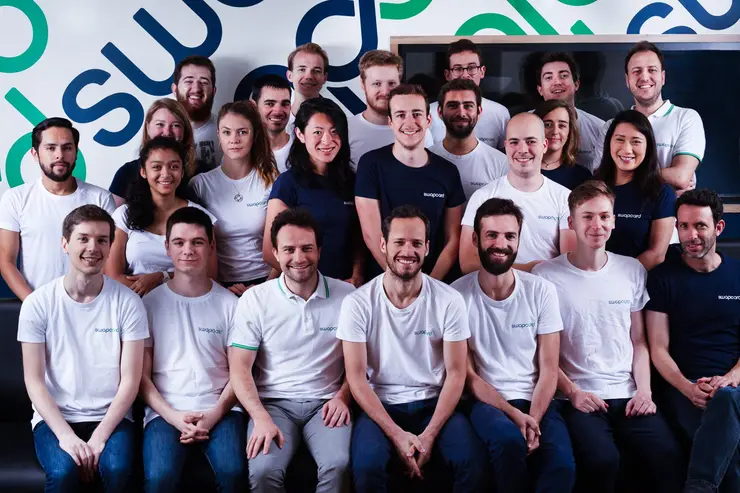
Fintech
How Formance uses Hyperline to manage custom pricing
Case study

Swapcard expanded from enterprise events to self-serve with usage-based pricing, but billing complexity quickly became a challenge. After struggling with Stripe and Lago, they turned to Hyperline. In less than two months, Swapcard launched seamless billing with credits, quotes, and integrations—empowering both sales and technical teams while scaling with confidence.

Swapcard is an AI-powered event platform that simplifies registration, networking, and analytics—helping organizers run seamless events and boost engagement.
When Swapcard introduced credit-based pricing, existing billing solutions fell short. Stripe Subscriptions couldn’t handle renewals and prorations properly, while alternatives required complex setups, lacked features like starting a subscription only after successful payment, and gated key functionality behind expensive plans.
Swapcard turned to Hyperline after a referral within their Growth network. The SaaS platform required no maintenance, covered all billing needs, and came with reliable support. Less than two months later, Swapcard was invoicing customers with minimal developer involvement.
Swapcard’s self-serve plan starts at €540 per year, with credits to scale participants and exhibitors, plus over ten optional add-ons like branded apps. Hyperline’s flexible credit management proved essential to making this model work.
With Hyperline, billing is now smooth and scalable. Sales and CS manage quotes, subscriptions, and checkouts directly in the platform or Salesforce, while engineers benefit from stability, fast fixes, and steady feature velocity. Billing has shifted from a bottleneck to a growth enabler for Swapcard’s self-serve business.
Swapcard is an AI‑powered event engagement platform that helps organizers—such as associations, trade shows, and conference planners—deliver richer, more connected experiences. Built to simplify both the online and onsite event journey, the platform supports everything from registration and ticketing to networking, check‑ins, and analytics. Central to its offering is intelligent matchmaking that helps attendees discover the right people, content, or exhibitors at exactly the right time. Behind the scenes, event teams benefit from an intuitive, customizable interface and real‑time insights that streamline operations while maximizing engagement and ROI.
Originally built as a sales-led SaaS serving large conferences and trade shows, the company has expanded its reach with a new self-serve product tailored for smaller organizations—typically events with up to 1,000 participants and around 30 exhibitors.
While the self-serve version offers the same core features—registration, ticketing, networking, and analytics—it comes with lighter support than Swapcard’s enterprise solution. Pricing is structured around the volume of participants and exhibitors, starting at €540 per year, with credits available to scale and more than 10 optional add-ons, such as custom event apps with branded logos.
Notable customers include organizations like 1format and Hemirable, alongside a growing base of event planners adopting the self-serve model to streamline their operations and increase engagement.
By introducing usage and credit-based pricing in its self-serve product, Swapcard also discovered the complexity that comes with managing such a model without the right tools. At the launch of the product four years ago, Stripe Subscriptions seemed like the natural choice for self-serve billing. But its limitations quickly became clear: renewals were difficult to manage, and prorations were a recurring headache, to name just a few.
Looking for alternatives, the team turned to Lago, an open-source solution. What followed was a five-month implementation effort for a platform with limited features. Key gaps included manual overage management on subscriptions, credit notes available only as paid features, and restricted support due to being on the open-source plan.
As Robin, Head of Growth at Swapcard, recalls:
“In the beginning, the support was great—we were early adopters. But very quickly, we were no longer a priority since we were on the open-source plan, and the support became very limited.”
Through a referral in his Growth network, Robin first heard about Hyperline and decided to give the platform a try. He signed up in self-serve and started exploring on his own. “It became clear right away that it covered everything we needed.”
He was convinced by both the product and the value proposition:
“I was also reassured after speaking with the team,” Robin adds. “I could see the product was moving in the right direction, with upcoming features that would only improve our experience on the platform.”
With his hybrid Growth/engineering profile, Robin was able to lead the entire billing project end-to-end, involving developers only minimally. Less than two months later, Swapcard was ready to invoice its first customers through Hyperline. “And honestly, it could have been even faster—Hyperline built a custom credits feature for us right when we needed it most, which made all the difference.”
Since moving to Hyperline, Swapcard has seen a steady stream of new features that made managing billing not only easier, but far more efficient:
For the team, the impact has been clear. Sales and CS teams now run their own quotes and manage subscriptions on the platform and/or from Salesforce, meaning non-technical users can handle billing tasks without relying on developers. On the technical side, engineers appreciate the product’s stability, speed of bug fixes, and the pace at which new features are released.
As Robin summarizes: “The experience is great for both technical and non-technical teams. Hyperline keeps shipping at a fast pace, listens closely to feedback, and makes us feel like we’re co-building the product together.”
